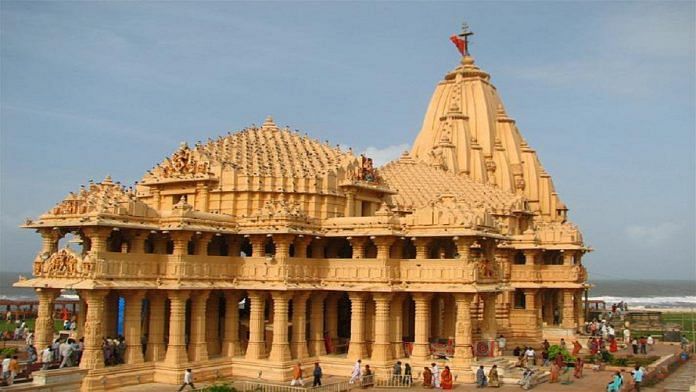New Delhi: Since the Supreme Court directed the Narendra Modi-led central government to form a trust that will eventually build a Ram Temple in Ayodhya, there has been much speculation about its composition.
While the government’s internal discussions have thrown up a suggestion to keep politicians out of it, as ThePrint reported, the Vishva Hindu Parishad wants Union Home Minister Amit Shah and Uttar Pradesh Chief Minister Yogi Adityanath to be a part of it.
News agency ANI, meanwhile, has quoted VHP sources as saying that the trust will be similar to the one in charge of the Somnath Temple in Gujarat, which has Prime Minister Narendra Modi and Shah as board members.
With the temple construction reportedly to begin on Ram Navami, which falls on 2 April next year, ThePrint takes a look at the Somnath temple trust to gauge what the Ayodhya trust could be like.
Also read: Throne for ‘Ram Lalla’, 424 pillars & a gaushala — What VHP’s temple in Ayodhya looks like
Patel’s assertion
In what seems like a parallel with Ayodhya, the Somnath temple was a contested site, with claims that the temple was destroyed by Mahmud Ghaznavi in 1026.
While the destruction of the temple remained an issue of regional interest for a while, it was taken up nationally in the years leading up to Independence and Partition. It found a place within the narrative of “Hindu pride”, and as a symbol of Muslim intolerance and iconoclasm.
It is believed that the first assertion of rebuilding the temple came from Sardar Vallabhbhai Patel, India’s deputy prime minister, at a huge public meeting in Junagadh on 12 November 1947.
BJP leader L.K. Advani, who, decades later, began his Ram Janmabhoomi Rath Yatra from Somnath, wrote in a blog post that was also included in his book My Take: “After returning to Delhi, he [Patel] secured Gandhiji’s blessings for the move [temple reconstruction] and had Pandit Nehru have it endorsed by his Cabinet. The Cabinet’s decision implied that the government would incur the expenditure. But that evening itself when Sardar Patel, Dr [K.M.] Munshi and N.V. Gadgil went to Gandhiji to apprise him of the Cabinet’s decision, Gandhiji welcomed it but added: Let the people and not the government bear the expenditure.”
A trust was then set up, with politician, writer and educationist K.M. Munshi as its chairman.
Also read: On KM Munshi’s birth anniversary, remembering his fight to rebuild Somnath Temple
Fund generation and Nehru’s opposition
According to an account in Munshi’s book Somnatha — The Shrine Eternal, Patel’s announcement to reconstruct the temple in 1947 was followed by the first few donations.
“Jam Saheb [of Nawanagar] gave the first donation of one lakh rupees for the reconstruction, followed by Rs 51,000 from Samaldas Gandhi representing the Junagadh administration,” he wrote.
But after Mahatma Gandhi’s suggestion to not take any money from the government, Patel returned the Jam Saheb cheque and suggested that the same amount be paid as a donation to the Somnath fund.
By the end of 1949, about Rs 25 lakh were collected. A trust deed was finally executed on 15 March 1950. Jam Saheb laid the foundation stone for the reconstruction on 8 May 1950.
The government appointed a committee of two engineers and an architect for the supervision of the reconstruction work. By 1951, the base and the inner sanctum of the temple were ready.
However, when President Rajendra Prasad was requested to participate in the installation of the lingam, Jawaharlal Nehru objected to any association with the reconstruction of the temple, calling it “Hindu revivalism”. President Prasad ignored Nehru’s objections and attended the ceremony.
Also read: After Ram Mandir, next on VHP agenda — reconstruction of J&K temples, cow protection
Trustees for life
The Shree Somnath trust is a religious charitable trust registered under the Gujarat Public Trust Act, 1950.
It is supposed to have eight members in total, but currently has seven — former Gujarat CM Keshubhai Patel is the chairman, while PM Modi, BJP chief Shah, former deputy PM Advani and former Gujarat chief secretary Pravin Laheri are all members. The other two members are Harshavardhan Neotia, chairman of the Kolkata-based Ambuja Neotia Group, and J.D. Parmar, retired professor of Sanskrit from Veraval.
Membership of the board is for life — Parmar has been a trustee since 1975, while Shah was appointed in January 2016 after Congress MP from Bhavnagar Prasannvadan Mehta passed away.
Vijay Singh Chawda, general manager of the trust, told ThePrint that the state government and the central government can nominate four trustees each. However, usually the ‘trustee mandal’ prepares a list of potential candidates and vacancies are filled from this list.
The trustees meet four times a year, Chawda said.
Also read: Why Mathura or Varanasi temple disputes won’t go the Ayodhya way
What the trust does
According to Chawda, last year, the trust generated Rs 42 crore through offerings, donations, and rent from the 400 hundred rooms it owns as part of various guest houses. The 2017 figure was Rs 39 crore.
Over the past two years, the Gujarat government has also spent Rs 31.47 crore to develop facilities around the Somnath temple.
Chawda said the trust has been distributing nutritious food among anganwadi children in the Gir Somnath district for the past three years, and also working towards training the unemployed — 1,000 people having been provided vocational training over the past two years. Around 700 of these have been employed since, Chawda said.
The trust also organises a five-day Kartiki Poonam mela every year, which is attended by around eight to nine lakh people. Several local artisans participate in the mela.
Prisoners from the local jail also sell pakoras and bhajiyas in the mela, Chawda said.
Also read: RSS won’t push Varanasi, Mathura mosque issues after Ayodhya verdict, says Mohan Bhagwat



